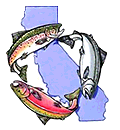Restoring Riparian Habitats: Successes, Challenges, and Practical Guidance for Practitioners
Session Coordinator: Ada Fowler, California Trout
A healthy riparian system provides a wide range of ecological benefits, including shade that helps keep stream temperatures cool for aquatic life, escape cover for fish and wildlife, and valuable allochthonous inputs such as leaves, wood, and insects that fuel the food web and add to the diversity of the stream ecosystem. Riparian vegetation also stabilizes banks, filters runoff, and supports diverse habitats. To ensure the conservation and recovery of salmonids and other imperiled native species, it is essential to not only look within the stream itself but also consider the condition of the stream banks. Many of our rivers have been altered by human activities, including altered hydrographs from dams and diversions, channel incision and groundwater extraction that lower the water tables, and livestock grazing, which degrade water quality, habitat complexity, and ecosystem resilience. Riparian restoration is critical, as it helps reestablish native vegetation, improve hydrologic connections, restore habitat structure, and ultimately enhance the resilience and ecological integrity of rivers and streams. Those of us who are practitioners of riparian revegetation efforts know how difficult it is to re-establish functioning riparian ecosystems in these altered environments. In this session, we invite speakers to present research and case studies related to riparian restoration, discussing their challenges and how they were addressed, and what has and hasn't worked in different landscapes. We aim to bring together individuals working on riparian restoration and share this knowledge to support those undertaking similar efforts.
